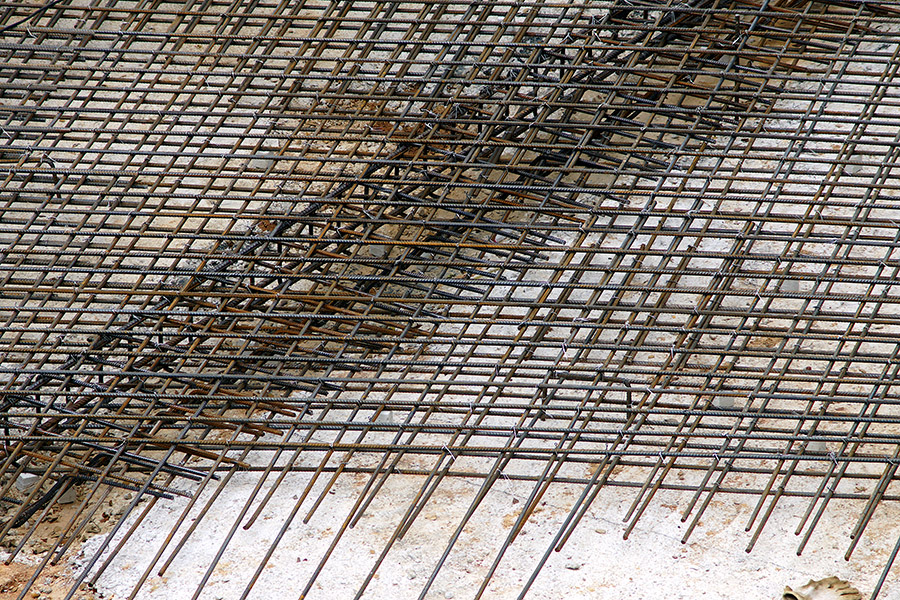In the scorching Arizona heat, a swimming pool isn’t just a luxury—it’s practically a necessity. Whether you’re designing a backyard oasis for your family or planning a commercial aquatic center, what lies beneath the surface determines whether your investment will stand the test of time or become a costly liability.
The structural integrity of any swimming pool begins with its foundation, and at the heart of that foundation is a properly installed rebar. While hidden from view once construction is complete, this reinforcing steel framework is what prevents cracking, shifting, and catastrophic structural failures that plague poorly constructed pools. For residential pool owners, this means protection against leaks and expensive repairs. For commercial pool operators, it’s essential protection against liability and compliance issues.
At Scholz Rebar, we’ve seen firsthand how proper rebar installation can mean the difference between a pool that lasts for decades and one that develops problems within just a few seasons. In Arizona’s unique soil conditions, where expansive clay and extreme temperature fluctuations put additional stress on concrete structures, professional rebar installation isn’t just recommended—it’s critical.
What Is Rebar and Why It’s Used in Pools
Understanding the Basics of Reinforcing Steel
Rebar, short for reinforcing bar, is specially manufactured steel designed to work in harmony with concrete. While concrete excels at handling compression forces, it’s relatively weak when it comes to tension and flexing. This is where rebar steps in—providing the tensile strength needed to create a truly durable structure.
In swimming pool construction, rebar typically consists of steel bars ranging from #3 (3/8-inch diameter) to #5 (5/8-inch diameter) for residential pools, with commercial pools often requiring even heavier gauges. These bars are arranged in precise grid patterns and tied together to create a three-dimensional skeleton that will be encased in concrete.
The Critical Role of Rebar in Pool Shells
A swimming pool shell must withstand multiple forces that threaten its structural integrity:
- Ground movement: Arizona’s soil can expand, contract, and shift with moisture and temperature changes
- Water pressure: Thousands of gallons of water exert continuous outward pressure
- Temperature fluctuations: Extreme heat followed by cooling can cause concrete to expand and contract
- Weight loads: Surrounding decks, equipment, and foot traffic create additional stress
Without proper reinforcement, these forces would quickly crack and compromise even the thickest concrete shell. Professional rebar installation creates a unified structure where the concrete and steel work together—the concrete resists compression while the rebar handles tension.
For residential pool rebar installation, the focus is often on creating a structure that maintains water integrity and prevents cracking. Commercial pool rebar installation demands additional considerations, including supporting higher user loads, accommodating larger water volumes, and meeting stringent commercial building codes.
The pattern, spacing, and gauge of rebar must be carefully engineered based on the pool’s design, soil conditions, and intended use. This is why experienced structural rebar contractors are invaluable partners in the pool construction process—they understand how to translate engineering specifications into real-world installations that provide decades of trouble-free performance.
Key Differences in Rebar Design for Residential vs. Commercial Pools
Load-Bearing Requirements
Residential and commercial swimming pools may serve similar purposes, but their structural requirements differ significantly. Commercial pools must withstand substantially higher load-bearing demands due to:
- Higher occupancy rates with dozens or even hundreds of simultaneous users
- Increased water volume and weight
- More frequent and intensive use patterns
- Additional features like diving boards, slides, and water features
These increased demands require commercial pool rebar frameworks to be more robust, with heavier gauge steel (#5 or larger), tighter spacing between bars, and additional reinforcement in high-stress areas. Professional commercial pool rebar contractors understand these unique requirements and design reinforcement systems that provide the necessary structural integrity.
Residential pool rebar installation, while still requiring precision, typically uses lighter gauge steel with standard spacing patterns. However, this doesn’t mean residential pools can skimp on reinforcement—even backyard pools must be built to withstand Arizona’s challenging soil conditions and temperature extremes.
Scale and Structural Complexity
Commercial pools often feature complex designs with varying depths, integrated spas, beach entries, and other architectural elements. These design features create structural transition points that require special attention during rebar installation.
The larger scale of commercial projects also means that rebar must be carefully planned to maintain structural continuity across greater distances. This often involves:
- Multiple layers of reinforcing steel
- Special attention to overlapping and corner reinforcement
- Integrated support for pool equipment and plumbing
- Reinforcement for adjacent deck structures
Residential pool rebar may be less complex but still requires careful planning to accommodate steps, benches, lighting niches, and other features. An experienced structural rebar contractor will ensure these transition areas receive appropriate reinforcement to prevent future stress cracking.
Regulatory and Compliance Considerations
Perhaps the most significant difference between residential and commercial pool rebar installation is the regulatory framework. Commercial pools must meet stringent building codes, ADA accessibility requirements, and public safety standards that don’t apply to residential installations.
Commercial pool rebar must be installed with mandatory inspections in mind—every aspect of the installation must be documented and verifiable. This includes:
- Precise rebar spacing measurements
- Proper chair heights to ensure adequate concrete coverage
- Documentation of steel gauge and grade
- Testing of tie wire integrity
While residential pools have fewer regulatory hurdles, professional pool builders still recommend following commercial-grade standards for rebar installation. This ensures long-term structural integrity and can prevent costly repairs down the road.
Common Mistakes in Pool Rebar Installation (And How to Avoid Them)
Poor Spacing and Inadequate Coverage
One of the most frequent errors we encounter in pool construction is improper rebar spacing. Rebar that’s placed too far apart creates weak points where concrete can crack under pressure. Conversely, rebar that’s too tightly packed can prevent concrete from properly flowing between the bars during the gunite or shotcrete process.
The ideal spacing depends on the pool’s design and engineering specifications, but generally ranges from 6 to 12 inches on center for residential pools and 4 to 8 inches for commercial applications. Proper spacing ensures uniform strength throughout the structure.
Equally important is maintaining adequate concrete coverage over the rebar. In Arizona’s harsh climate, insufficient coverage can lead to moisture penetration, causing the steel to rust and expand. This expansion creates internal pressure that cracks the concrete from within. Professional pool rebar installation includes the use of proper chairs and spacers to elevate the steel and ensure it sits at the correct depth within the concrete shell.
Inadequate Tying or Incorrect Gauge
The strength of a rebar framework depends not just on the steel itself, but on how securely the grid is assembled. Each intersection point must be properly tied with wire to prevent shifting during the concrete application process. Loose or missing ties can allow the rebar to move, creating weak spots in the final structure.
Another common issue is using undersized rebar to cut costs. While #3 rebar might be sufficient for some residential applications, many pool designs require #4 or #5 rebar to provide adequate strength. Commercial pools often require even heavier gauges. Using the wrong size can compromise the entire structure and lead to premature failure.
The best practice is to follow engineering specifications precisely and never substitute smaller gauge steel than what’s called for in the plans. When working with Scholz Rebar, you can be confident we never cut corners on materials or installation techniques.
Inspection Challenges and Documentation
Pool rebar installation presents unique inspection challenges because once the concrete is applied, the reinforcement is no longer visible. This means any errors or omissions in the rebar framework become permanently hidden—but not without consequences.
To avoid issues, professional rebar contractors implement rigorous quality control measures:
- Detailed photographic documentation of the completed rebar framework
- Pre-inspection checklists to verify spacing, coverage, and tie integrity
- Coordination with building inspectors for timely site visits
- Thorough documentation of any field adjustments to engineering plans
For commercial pool projects, this documentation isn’t just good practice—it’s often a legal requirement. For residential pools, maintaining similar standards helps ensure peace of mind for both the builder and homeowner.
At Scholz Rebar, we approach every swimming pool project with the same attention to detail, regardless of size. Our comprehensive inspection process catches potential issues before concrete is ever applied, saving our clients from expensive remediation down the road.
How Scholz Rebar Ensures Quality and Code Compliance
Our Professional Process for Rebar Layout and Installation
At Scholz Rebar, we’ve developed a systematic approach to pool rebar installation that ensures consistent quality and structural integrity. Our process begins long before steel is placed in the excavation:
- Detailed plan review: Our team carefully analyzes engineering specifications and pool designs to identify critical structural elements and potential challenges.
- Material selection: We source only high-quality, grade-marked reinforcing steel that meets or exceeds ASTM standards for pool construction.
- Precision layout: Using laser measuring tools, we establish exact grid patterns that conform to engineering requirements.
- Skilled installation: Our experienced crews follow industry best practices for cutting, bending, and securing rebar with proper overlap at critical junctions.
- Quality verification: Supervisors perform comprehensive checks of spacing, tie integrity, and alignment before scheduling inspections.
This methodical approach has made us a trusted structural rebar contractor for swimming pools throughout Arizona. For residential pool rebar installation, our attention to detail prevents the common problems that lead to leaks and premature aging. For commercial pool rebar installation, our process ensures compliance with even the most stringent building codes.
Experience Working with Builders and Engineers
What truly sets Scholz Rebar apart is our collaborative approach to pool construction. We understand that successful projects require seamless coordination between:
- Architects and designers who envision the pool
- Engineers who specify structural requirements
- Excavation crews who prepare the site
- Concrete contractors who complete the shell
- Plumbing and electrical specialists who install systems
Our team has developed strong working relationships with the leading pool builders and engineers in Arizona. This means we can anticipate challenges before they arise and provide valuable input during the planning stages—often identifying potential structural issues before they become expensive problems.
For complex commercial pool projects, this early collaboration is particularly valuable. Our experience with large-scale aquatic facilities means we can work effectively with engineering teams to develop rebar solutions for even the most challenging designs. For residential pools, our relationships with custom home builders ensure that backyard projects proceed smoothly and efficiently.
Conclusion: Why Professional Rebar Installation Makes All the Difference
The difference between a swimming pool that provides decades of trouble-free enjoyment and one that becomes a maintenance nightmare often comes down to what you can’t see—the structural rebar framework that gives the concrete shell its strength and durability.
In Arizona’s challenging environment, where soil movement and temperature extremes put constant stress on pool structures, professional rebar installation isn’t a luxury—it’s a necessity. Whether you’re building a residential backyard retreat or a commercial aquatic center, the quality of your rebar installation will determine the long-term success of your investment.
At Scholz Rebar, we’ve built our reputation on providing the highest quality structural rebar for pools throughout Arizona. Our team brings decades of combined experience to every project, ensuring that your pool receives the solid foundation it deserves.
Ready to Build a Pool That Lasts?
If you’re planning a swimming pool project—whether residential or commercial—Scholz Rebar is ready to help ensure its structural integrity. Contact us today for a consultation and discover why leading pool builders throughout Arizona trust us with their most demanding projects.
Serving Phoenix, Scottsdale, Tempe, Mesa, Chandler, Glendale, and surrounding Arizona communities

